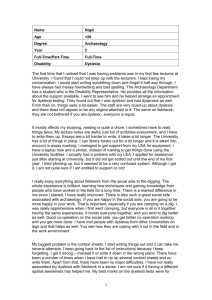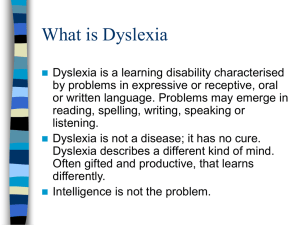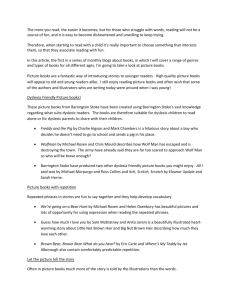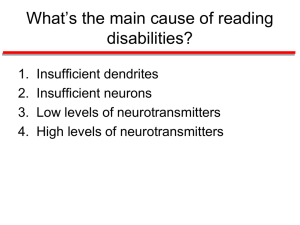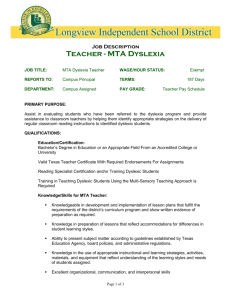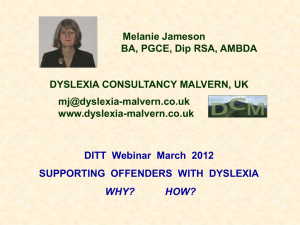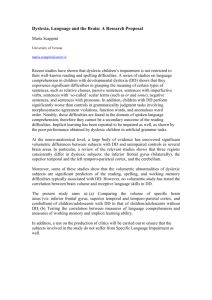Speech- and sound-segmentation in dyslexia: evidence for a
advertisement
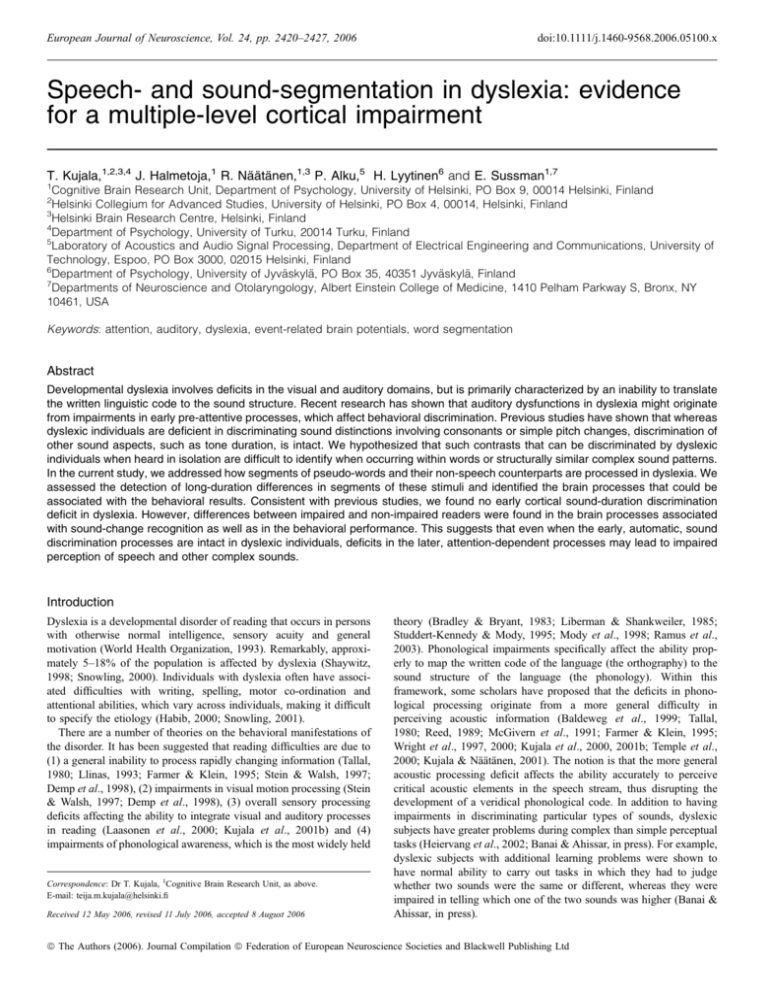
European Journal of Neuroscience, Vol. 24, pp. 2420–2427, 2006 doi:10.1111/j.1460-9568.2006.05100.x Speech- and sound-segmentation in dyslexia: evidence for a multiple-level cortical impairment T. Kujala,1,2,3,4 J. Halmetoja,1 R. Näätänen,1,3 P. Alku,5 H. Lyytinen6 and E. Sussman1,7 1 Cognitive Brain Research Unit, Department of Psychology, University of Helsinki, PO Box 9, 00014 Helsinki, Finland Helsinki Collegium for Advanced Studies, University of Helsinki, PO Box 4, 00014, Helsinki, Finland 3 Helsinki Brain Research Centre, Helsinki, Finland 4 Department of Psychology, University of Turku, 20014 Turku, Finland 5 Laboratory of Acoustics and Audio Signal Processing, Department of Electrical Engineering and Communications, University of Technology, Espoo, PO Box 3000, 02015 Helsinki, Finland 6 Department of Psychology, University of Jyväskylä, PO Box 35, 40351 Jyväskylä, Finland 7 Departments of Neuroscience and Otolaryngology, Albert Einstein College of Medicine, 1410 Pelham Parkway S, Bronx, NY 10461, USA 2 Keywords: attention, auditory, dyslexia, event-related brain potentials, word segmentation Abstract Developmental dyslexia involves deficits in the visual and auditory domains, but is primarily characterized by an inability to translate the written linguistic code to the sound structure. Recent research has shown that auditory dysfunctions in dyslexia might originate from impairments in early pre-attentive processes, which affect behavioral discrimination. Previous studies have shown that whereas dyslexic individuals are deficient in discriminating sound distinctions involving consonants or simple pitch changes, discrimination of other sound aspects, such as tone duration, is intact. We hypothesized that such contrasts that can be discriminated by dyslexic individuals when heard in isolation are difficult to identify when occurring within words or structurally similar complex sound patterns. In the current study, we addressed how segments of pseudo-words and their non-speech counterparts are processed in dyslexia. We assessed the detection of long-duration differences in segments of these stimuli and identified the brain processes that could be associated with the behavioral results. Consistent with previous studies, we found no early cortical sound-duration discrimination deficit in dyslexia. However, differences between impaired and non-impaired readers were found in the brain processes associated with sound-change recognition as well as in the behavioral performance. This suggests that even when the early, automatic, sound discrimination processes are intact in dyslexic individuals, deficits in the later, attention-dependent processes may lead to impaired perception of speech and other complex sounds. Introduction Dyslexia is a developmental disorder of reading that occurs in persons with otherwise normal intelligence, sensory acuity and general motivation (World Health Organization, 1993). Remarkably, approximately 5–18% of the population is affected by dyslexia (Shaywitz, 1998; Snowling, 2000). Individuals with dyslexia often have associated difficulties with writing, spelling, motor co-ordination and attentional abilities, which vary across individuals, making it difficult to specify the etiology (Habib, 2000; Snowling, 2001). There are a number of theories on the behavioral manifestations of the disorder. It has been suggested that reading difficulties are due to (1) a general inability to process rapidly changing information (Tallal, 1980; Llinas, 1993; Farmer & Klein, 1995; Stein & Walsh, 1997; Demp et al., 1998), (2) impairments in visual motion processing (Stein & Walsh, 1997; Demp et al., 1998), (3) overall sensory processing deficits affecting the ability to integrate visual and auditory processes in reading (Laasonen et al., 2000; Kujala et al., 2001b) and (4) impairments of phonological awareness, which is the most widely held Correspondence: Dr T. Kujala, 1Cognitive Brain Research Unit, as above. E-mail: teija.m.kujala@helsinki.fi Received 12 May 2006, revised 11 July 2006, accepted 8 August 2006 theory (Bradley & Bryant, 1983; Liberman & Shankweiler, 1985; Studdert-Kennedy & Mody, 1995; Mody et al., 1998; Ramus et al., 2003). Phonological impairments specifically affect the ability properly to map the written code of the language (the orthography) to the sound structure of the language (the phonology). Within this framework, some scholars have proposed that the deficits in phonological processing originate from a more general difficulty in perceiving acoustic information (Baldeweg et al., 1999; Tallal, 1980; Reed, 1989; McGivern et al., 1991; Farmer & Klein, 1995; Wright et al., 1997, 2000; Kujala et al., 2000, 2001b; Temple et al., 2000; Kujala & Näätänen, 2001). The notion is that the more general acoustic processing deficit affects the ability accurately to perceive critical acoustic elements in the speech stream, thus disrupting the development of a veridical phonological code. In addition to having impairments in discriminating particular types of sounds, dyslexic subjects have greater problems during complex than simple perceptual tasks (Heiervang et al., 2002; Banai & Ahissar, in press). For example, dyslexic subjects with additional learning problems were shown to have normal ability to carry out tasks in which they had to judge whether two sounds were the same or different, whereas they were impaired in telling which one of the two sounds was higher (Banai & Ahissar, in press). ª The Authors (2006). Journal Compilation ª Federation of European Neuroscience Societies and Blackwell Publishing Ltd Sound segmentation in dyslexia 2421 By and large, previous studies on dyslexia have assessed the neural processing of sound contrasts in isolation (e.g. ⁄ ba ⁄ vs. ⁄ da ⁄ or ⁄ i ⁄ vs. ⁄ e ⁄ ), whereas in natural speech these minimal-difference pairs seldom occur in isolation. Moreover, some studies have suggested that stimulus complexity or masking effects might affect the ability of dyslexic individuals to perceive sound differences (Schulte-Körne et al., 1999; Kujala et al., 2000, 2003). This is more likely to be evident for word-length acoustic information than isolated syllables. Therefore, in the current study, we evaluated how dyslexic individuals perceive and process speech-sound contrasts in their natural context, embedded within words. The critical contrast used in the present study was a relatively long duration difference (200 vs. 100 ms). Although dyslexic subjects (children) may have problems in discriminating duration differences of relatively short sounds (100 vs. 33 ms; Corbera et al., 2006), the discrimination of long-duration sounds (200 vs. 160, 120, 80 and 40 ms) was suggested to be unimpaired in dyslexic adults (Baldeweg et al., 1999). The results showed that when these long-duration sounds were presented as single events (without surrounding sounds) in sequences, dyslexic subjects had a normal cortical mismatch negativity (MMN) response for the deviant stimuli. Furthermore, they behaviorally discriminated deviant sounds equally well as non-dyslexic control subjects. We hypothesized that even such a large contrast that can be discriminated by dyslexic individuals when heard in isolation would be difficult to identify when occurring within complex word-length information. Additionally, we used both speech (pseudo-words) and similar non-speech (tone patterns) as stimuli in the current study to address the issue of whether auditory impairments in dyslexia are specific to speech sounds or may be more general to acoustic processing mechanisms. To distinguish different sensory-information processing stages preceding the behavioral response, we recorded evoked neural responses (event-related brain potentials), which provide high temporal resolution and are time-locked to stimulus events. Therefore, they are highly conducive to determine the timing of cognitive processes underlying, and leading to, perception. Neural responses were recorded while subjects, in separate sessions, watched a video and ignored sounds and while they attended to them and responded with a button press to deviant segments. Early cortical processes underlying sound discrimination were assessed with the MMN brain response, which is elicited 100–250 ms after a change in sound stimulation whether or not the sounds are attended to (Näätänen, 1992). The MMN amplitude reflects the magnitude of the physical difference between sounds and is associated with behavioral measures of sound discrimination (Tiitinen et al., 1994; Amenedo & Escera, 2000; Kujala et al., 2001a; Sussman et al., 2001). Therefore, it has been suggested that MMN is a cortical correlate of sound discrimination accuracy (Näätänen, 1992). However, MMN and behavioral measures do not always reveal corroborating results (e.g. Bradlow et al., 1999) as behavioral data are affected by a variety of cognitive factors, such as attention, decision processes and motivation. When sound sequences are attended, the N2b and P3b responses are elicited after the MMN. These attention-related responses occur successively (N2b, 200–300 ms; P3b, 300–800 ms). They are associated with attentive deviant detection and recognition (Sutton et al., 1965; Näätänen et al., 1982; Näätänen & Gaillard, 1983; Donchin & Coles, 1988; Novak et al., 1992; Polich & Kok, 1995). The N2b is elicited when the subject becomes aware that a change has occurred in the stimulus sequence. P3b, in turn, indicates identification of a target stimulus. The purpose of the current study was to determine how dyslexic adults discriminate duration contrasts within speech and complex sounds by using a combination of behavioral and electrophysiological measures and to determine the stages of cognitive processing (e.g. early, automatic sound discrimination, attentive deviant identification) that are impaired in dyslexia. Materials and methods Subjects Data were collected from nine dyslexic adults (aged 19–40 years, mean 27 years; five males) and nine non-dyslexic (control) adults (aged 18–39 years, mean 25 years; four males). Informed consent was obtained from the subjects, and the study conforms with The Code of Ethics of the World Medical Association (Declaration of Helsinki). The dyslexic and control groups were matched for educational background. Three subjects in the dyslexic group were university students, two had a senior high school education, one was a senior high school student (having finished a vocational school) and three had vocational education. Four subjects in the control group were university students, one was a senior high school student and four had vocational education. The subjects had normal hearing and normal (or corrected to normal) vision, they were healthy and without medication affecting the central nervous system. Diagnosis of dyslexia was made in elementary school. Current level of reading function was also evaluated prior to the experiment using a reading-skill test designed and created for Finnish adults (Leinonen et al., 2001). The test is based on normative data involving 20– 40 year-old individuals. The subtests included in the present study were accuracy and speed in text reading and accuracy in reading pseudo-words. This test battery also includes an interview with which the reading problems both in childhood and in adulthood were determined. Additionally, the subjects completed a questionnaire describing their current problems related to reading and writing. The interview revealed a reading impairment in all subjects included in the dyslexic group. Furthermore, all but one dyslexic subject performed below 1 standard deviation of the reference population in at least one of the three variables in the reading test (Table 1). According to the interview, this subject clearly had dyslexia in her childhood, and was considered a ‘compensated dyslexic’ in adulthood. Therefore, the data were not excluded from the study. In the answers to the questionnaire, all dyslexic subjects reported that they have letter omissions or reversals in writing and confusion between certain phonemes such as b-d, b-p, t-d, k-g, i-e, nk-ng, and ⁄ or problems with speech-sound duration perception. Stimulation and procedure The stimuli were three-syllable Finnish pseudo-words and their nonphonetic counterparts (complex tone patterns with three segments) presented in separate conditions (Speech Condition and Tone Condition, respectively). The stimulus sequences were composed of repetitive standard stimuli (p. 0.79) and occasional deviant stimuli (p. 0.07 for each deviant-stimulus type), presented pseudo-randomly (at least one standard pseudo-word ⁄ tone pattern preceding the stimuli that included a deviant segment). In each deviant pseudo-word and tone pattern, there was only one deviant segment. The Finnish pseudo-word [tatata] and its non-phonetic complex sound counterpart, which approximated the acoustic complexity of the pseudo-word in the spectral domain (see also Sussman et al., 2004), served as standard stimuli. The sounds of the pseudo-words (total length 390 ms) were synthesized by concatenating a wave form of the plosive ⁄ t ⁄ cut from a word produced by a real speaker ª The Authors (2006). Journal Compilation ª Federation of European Neuroscience Societies and Blackwell Publishing Ltd European Journal of Neuroscience, 24, 2420–2427 2422 T. Kujala et al. Table 1. Results from the dyslexia tests and questionnaire on current problems in reading and writing Dyslexia tests* Normative data Dyslexic Dyslexic Z-scores Questionnaire Reading scores Accuracy (errors) Speed (s) 10.8 ± 11.8 120.4 ± 23.9 31.7 ± 16.2 165.1 ± 31.4 )1.8 ± 1.4 )1.9 ± 1.3 – – Pseudo-word naming (errors) Problems with phoneme duration Letter omissions ⁄ reversals Letter confusions Word parts missing Slow reading Lines get confused 11.4 ± 6.7 – – – – – – )1.5 ± 1.4 – – – – – – – 7⁄9 9⁄9 8⁄9 7⁄9 5⁄9 5⁄9 4.0 ± 5.0 – – – – – – *Means ± SD of the raw data values for reading accuracy (number of errors), speed and pseudo-word naming (number of errors) in normative data and in dyslexic subjects. On the right, Means ± SD of the Z-scores. These were obtained by subtracting the number of errors (accuracy) and the time in seconds used for reading the text passage (speed) from the corresponding values of the normative data. Thereafter, the values obtained were divided by the standard deviation of the normative data. Results from the questionnaire. The number indicates how many of the dyslexic subjects (n ¼ 9) responded having such a problem. Phoneme duration: single vs. double consonants and vowels (common in the Finnish language). Letter omissions ⁄ reversals: letters are missing or they are in wrong parts of the word in written text. Letter confusions: letter pairs such as b-d, b-p, t-d, k-g, i-e may be confused. Word parts missing: when reading or writing, parts of words may be missing. Fig. 1. Spectra of the stimuli illustrating the vowel segment of the pseudowords (upper panel) and the corresponding tone-composite of the non-speech tone-pattern stimulus (lower panel). to the waveform of the vowel ⁄ a ⁄ generated by the SSG (Semisynthetic Speech Generation) method (Alku et al., 1999; Fig. 1). With an SSG, vowel ⁄ a ⁄ of two different segment durations, 100 ms for standard and 200 ms for deviant stimuli, were produced, which were then used together with the plosive ⁄ t ⁄ in synthesizing the pseudo-words. The SSG was used as it yields naturally sounding vowels with formants (i.e. resonances of the vocal tract that determine the phoneme) that can be adjusted as desired. In addition, the modification of the vowel duration is straightforward in the SSG. The segments of the non-phonetic complex sound patterns were composed of four sinusoidals, the frequencies and intensity levels of which matched the strongest harmonics in the vicinity of the lowest four formants of the vowel ⁄ a ⁄ : 490, 1195, 2175 and 3725 Hz (Fig. 1). Stop gaps occurred in the beginning of each non-phonetic segment. Finally, the energies of the pseudo-words and their non-phonetic counterparts were normalized. The stimuli were binaurally presented with intensity of 50 dB (SPL) above the individual hearing threshold with a stimulus-onset asynchrony of 860 ms in three blocks of pseudo-word and three blocks of tone pattern stimuli. Half of the subjects were presented with tone patterns (Tone Condition) first and the other half with pseudo-words (Speech Condition) first. These conditions were administered in two sessions: ignore and attend. In the ignore session, subjects watched a silent movie and ignored auditory stimuli. In the attend session, subjects listened to the sounds and were instructed to press one of the three response keys corresponding to the position of the detected deviant segment. Every time the subjects recognized a deviant stimulus, they pressed button #1 (with their index finger) if they identified the deviant as occurring in the first segment of the pseudoword (Speech Condition) or of the tone pattern (Tone Condition); button #2 (with their middle finger) for a deviant in the second segment, and button #3 (with their ring finger) for a deviant in the third segment. Subjects used their preferred hand for the behavioral task. Before this session, a short practice block was run to familiarize subjects with the task. Each stimulus block included 750 stimuli in the ignore session and 550 stimuli in the attend session. The ignore session was always presented before the attend session in order to avoid possible carry-over effects of attention. Brain-activity recording and data analysis An electroencephalogram (EEG) was recorded (DC recording, 40-Hz low pass, sampling rate 500 Hz) with the NeuroScan system and SYNAMPS amplifiers from electrodes placed at the F3, C3, P3, Fz, Cz, Pz, F4, C4 and P4 locations (according to the international 10–20 system) on the scalp, and on the left and right mastoids. The nose was used as a reference. Horizontal eye movements were monitored with ª The Authors (2006). Journal Compilation ª Federation of European Neuroscience Societies and Blackwell Publishing Ltd European Journal of Neuroscience, 24, 2420–2427 Sound segmentation in dyslexia 2423 Fig. 2. Behavioral target detection. Mean hit rate, false alarm rate, discrimination accuracy rate and reaction time (with standard errors of mean). The reaction time was calculated from the beginning of the stimulus. Segments 1, 2, and 3 refer to the corresponding position (first, middle and last, respectively) in the stimulus. Significant (P < 0.01–0.05) group differences in the performance are marked with asterisks. Fig. 3. Brain responses elicited by standard pseudo-word and tone-pattern stimuli. The onsets of the sound segments of the standard stimuli elicit N1 responses. Arrows point to a significant N1 amplitude (the second segment in speech and tone patterns, ignore session) and latency (the second segment in pseudo-words, attend session) difference between the groups. electrodes placed on the left and right canthi, and vertical eye movements with electrodes placed above and below the right eye. The EEG was digitally filtered with a bandpass of 1.5–15 Hz (24 dB per octave). Neural responses were obtained by averaging EEG epochs separately for the three different deviant stimulus types and for the standard stimuli. The length of the analysis epoch was 1100 ms, beginning 100 ms before and terminating 1000 ms after stimulus onset. The epochs contaminated by eye movements or artifacts of nonbiological origin producing a voltage of ±100 lV at any electrode were removed. In addition, the responses to the first ten stimuli of each block were omitted from averaging. The N1, response to sound onset (Näätänen & Picton, 1987), was identified from the responses elicited by the standard stimuli. The MMN, N2b and P3b, reflecting stimulus-change discrimination and identification (Näätänen, 1992), were identified from the deviantminus-standard difference waves. The amplitudes of the neural responses were measured by first determining the peak latency from the grand-mean difference waveforms at Fz for the MMN, at Cz for the N2b and at Pz for the P3b, and from the grand-mean standard responses at Cz for the N1, and then measuring the amplitude using a 40-ms window centered on the grand-mean peak latency. Because the MMN and N2b may sometimes overlap, the data at mastoid leads were taken into account in determining the latency of the MMN, which inverts its polarity at mastoids unlike the N2b (e.g. Näätänen, 1992). Data recorded from all nine scalp electrodes were included in the amplitude and scalp-distribution analyses. Group differences were assessed with mixed-mode anova, including factors of Group (control vs. dyslexic), Front-to-back electrode location (frontal vs. central vs. parietal) and Lateral electrode location (left vs. central vs. right). Planned comparisons were carried out by running an anova separately for each response elicited by the three stimulus positions in the speech and non-speech stimuli. ª The Authors (2006). Journal Compilation ª Federation of European Neuroscience Societies and Blackwell Publishing Ltd European Journal of Neuroscience, 24, 2420–2427 2424 T. Kujala et al. Fig. 4. Brain responses elicited by deviant pseudo-word and tone-pattern stimuli in the ignore (at frontal Fz electrode, at which the MMN is largest) and attend sessions (at central Cz electrode, at which the N2b is largest and at parietal Pz electrode, at which the P3b is largest). The responses are deviant-minus-standard difference waves. Segments 1, 2, and 3 refer to the corresponding position (first, middle and last, respectively) of the deviant sound in the pseudo-word ⁄ tone pattern. In the ignore session, an MMN is elicited by each deviant segment with a similar amplitude in both groups. In the attend session, the deviant segments elicit a prominent N2b and P3b. Significant amplitude differences were found between the groups for the N2bs elicited by the 3rd deviant speech segment and by all deviant tone pattern segments (marked with arrows). Behavioral measures and data analysis Results Button presses were classified as hits when a correct button (#1 for a deviant in the first segment, #2 for the second and #3 for the third) was pressed within 150–1500 ms from deviant-stimulus onset. Button presses outside that window and incorrect responses (e.g. pressing button #1 when a deviant occurred in the second segment) were regarded as a false alarms. Hit rates (HR) and false alarm (FA) rates were calculated for each token type (speech and non-speech) and segment. Then, the probability that a response was correct (‘discrimination-accuracy rate’) was calculated by dividing the number of hits by the number of hits plus FAs for each subject, token type and segment position, individually. A secondary analysis was done on the FAs to determine the type of errors both groups made. When participants pressed the key erroneously, we analysed the percentage of errors of misidentifying the position of the deviant within the stimulus (i.e. indicating that the wrong segment was deviant). Reaction time (RT) was measured from stimulus onset. Group differences in HR, FA, accuracy rate and RT were analysed with separate one-way anovas for each token type and deviant stimulus segment. Behavioral sound discrimination Dyslexic subjects performed worse than control subjects in the target identification task (Fig. 2). HR was lower (F1,16 ¼ 6.83–15.91, P < 0.02) and FA rate was higher (F1,16 ¼ 9.70–13.89, P < 0.01) in dyslexic than in control subjects for all other deviant segments except for the second segment in pseudo words. The discrimination-accuracy rate was significantly lower in the dyslexic than control subjects for each deviant pseudo-word and tone-pattern segment (F1,16 ¼ 6.15– 17.57, P < 0.03). The RT was significantly longer in the dyslexic than control subjects for the middle segment of the pseudo-words (F1,16 ¼ 6.99, P < 0.02), whereas for the tone-pattern segments and for the first and the third pseudo-word segments, the difference did not reach significance (F1,16 ¼ 3.34–3.62, P < 0.09). Analysis of the types of false button presses showed that false alarms never occurred to standard stimuli for either group. Thus, the FA rate fully reflected detection of a deviant but misidentification of the position within the stimulus where the deviant occurred. The rate of misidentification of the deviant position within the stimulus was significantly higher for the dyslexic group than the control group ª The Authors (2006). Journal Compilation ª Federation of European Neuroscience Societies and Blackwell Publishing Ltd European Journal of Neuroscience, 24, 2420–2427 Sound segmentation in dyslexia 2425 Table 2. The amplitudes and latencies of MMN (Ignore Condition, Fz), N2b (Attend Condition, Cz) and P3b (Attend Condition, Pz) Speech condition Tone condition Control Dyslexic Control Dyslexic )2.9 ± 0.3 )3.4 ± 0.5 )2.1 ± 0.5 )2.7 ± 0.4 )2.9 ± 0.5 )1.6 ± 0.3 )3.1 ± 0.5 )2.6 ± 0.3 )2.5 ± 0.4 )2.2 ± 0.3 )2.4 ± 0.5 )1.8 ± 0.4 MMN latency (ms) Segment 1 Segment 2 Segment 3 237 ± 5 385 ± 5 532 ± 8* 235 ± 6 381 ± 4 509 ± 5* 246 ± 3 388 ± 4 534 ± 9 244 ± 1 378 ± 5 520 ± 6 N2b amplitude (lV) Segment 1 Segment 2 Segment 3 )4.0 ± 1.0 )5.1 ± 1.4 )9.2 ± 2.1* )1.6 ± 1.1 )1.8 ± 0.9 )2.0 ± 1.3* )4.1 ± 1.0* )4.4 ± 1.7* )5.9 ± 1.6* )0.4 ± 0.7* )0.0 ± 0.6* )1.8 ± 0.7* MMN amplitude (lV) Segment 1 Segment 2 Segment 3 N2b latency (ms) Segment 1 Segment 2 Segment 3 306 ± 7 447 ± 8 584 ± 4 328 ± 12 435 ± 12 583 ± 10 321 ± 11 433 ± 10 591 ± 12 326 ± 17 486 ± 15 571 ± 13 P3b amplitude (lV) Segment 1 Segment 2 Segment 3 4.2 ± 1.0 4.8 ± 1.3 5.3 ± 1.0 3.9 ± 0.9 3.0 ± 1.0 2.0 ± 0.9 5.0 ± 0.9 3.5 ± 0.9 3.9 ± 0.8 4.5 ± 0.9 2.9 ± 0.9 2.4 ± 0.8 P3b latency (ms) Segment 1 Segment 2 Segment 3 453 ± 19 575 ± 14 723 ± 11 455 ± 11 583 ± 14 696 ± 21 453 ± 11 599 ± 11 734 ± 14 446 ± 8 584 ± 8 716 ± 19 Data are given as means ± SEM. The latencies were determined from the onset of the deviant pseudo-word or complex-tone. *Significant group differences (main effects). (F1,16 ¼ 9.70–13.89, P < 0.01) for all segments except for the second speech segment for which it was marginally significant (F1,16 ¼ 3.86, P < 0.07). Cortical standard-sound processing The N1 response to standard-stimulus onsets or onsets of the third segment showed no significant differences between dyslexic and control subjects. However, in response to the second segment onset in the Ignore Condition, the N1 amplitude was significantly higher in dyslexic than control subjects for both speech (F1,16 ¼ 6.35, P < 0.03) and non-speech (F1,16 ¼ 5.15, P < 0.04) stimuli. In the attend session, the second segment of the pseudo-words elicited an N1 with a shorter latency in control than dyslexic subjects (F1,16 ¼ 5.26, P < 0.04; Fig. 3). No other significant differences in standard-sound processing were observed. Pre-attentive cortical sound-change discrimination In the ignore session, significant MMNs were elicited by all deviant segments in both groups (t8 ¼ 5.20–9.84, P < 0.004; Fig. 4, Table 2). There were no other group differences in the MMN latencies or amplitudes either for the pseudo-words or tone patterns except for a shorter MMN latency in the dyslexic than control subjects for the lastsegment deviant of the pseudo-words (F1,16 ¼ 6.12, P < 0.03). However, there was a significant difference in MMN scalp topography between the groups for the tone deviance at the end of the stimulus (F4,46 ¼ 2.74, P < 0.04, Group · Front-back laterality interaction). This was due to diminished parietal and left-hemisphere MMNs in the dyslexic subjects. Attentive cortical deviant-sound identification The most striking finding was the absence of the N2b in dyslexic subjects for attended stimuli (Fig. 4). N2b was elicited by all deviant segments of attended stimuli in control subjects (t8 ¼ 2.58–4.43, P < 0.04), whereas the response in the expected latency range of N2b was not significantly different from zero in dyslexic subjects. Furthermore, the difference waveforms showed a significantly stronger neural activity at the N2b latency range for the control than dyslexic subjects for each tone-segment change (F1,16 ¼ 4.75–7.75, P < 0.05). Group differences were also found for the speech sounds but they were significant only when the deviant was in the last segment, which elicited an N2b with a lower amplitude in dyslexic than control subjects (F1,16 ¼ 8.40, P < 0.02). This result can also be accounted for by the absence of N2b in the dyslexic group. The P3b was elicited by deviant segments in all three positions and both stimulus types for the control group (t8 ¼ 2.93–5.38, P < 0.02). In dyslexic subjects, the P3b was elicited by deviant segments in all positions of non-speech sounds and for the beginning and middle segments of the speech sounds. For the last segment speech deviant, the P3b was marginally significant (t8 ¼ )2.28, P < 0.06). No significant group differences (group main effects) were found in the P3b latencies or amplitudes. There were significant Group · Frontback interactions, revealing more prominent P3b responses in parietal scalp regions in control than dyslexic subjects for the second and third deviant-tone segment (F2,32 ¼ 3.37–13.90, P < 0.04). Discussion Our results show that dyslexic individuals are severely impaired in identifying relatively long-duration contrasts (100 vs. 200 ms) ª The Authors (2006). Journal Compilation ª Federation of European Neuroscience Societies and Blackwell Publishing Ltd European Journal of Neuroscience, 24, 2420–2427 2426 T. Kujala et al. embedded within speech and complex sounds. A previous study showed no differences between dyslexic and control subjects in discriminating tones with durations of 200 ms vs. 160, 120, 8, and 40 ms presented in isolation (Baldeweg et al., 1999). Thus, it can be suggested that sounds that are easily discriminated by dyslexic adults when presented in isolation are hard to identify when occurring within words or other complex sounds. It has been proposed that the key difficulty in speech perception in dyslexia is the perception of brief or rapidly occurring elements (Tallal, 1980; Reed, 1989; Farmer & Klein, 1995; Temple et al., 2000). Our results show that the perceptual impairment in dyslexia is more intricate than one confined to discriminating brief or rapidly presented sounds. When appearing in a natural context, within speech or complex sounds, even large differences of long-duration sounds were difficult for dyslexic individuals to discriminate. Although there was some indication on abnormal neural generators of the MMN in dyslexia (a group difference of MMN topography for the last tone segment), no statistically significant group differences (main effects) were found in MMN amplitudes. This result is consistent with previous findings on duration discrimination of relatively long sounds (standard sound being 200 ms) presented in isolation (Baldeweg et al., 1999). The unaffected MMN amplitude suggests that the early cortical discrimination of the duration difference was not impaired in dyslexic individuals. However, even though the duration contrasts were automatically discriminated in the cortex, they were not attentively detected, as shown by the absence of the later N2b response and impaired behavioral discrimination in dyslexic subjects. Thus, the deficit of the dyslexic subjects was in the attentive identification of the duration contrasts. These results illustrate the complexity of the disorder. Whereas the discrimination of some sound features (e.g. stimulus frequency) is impaired at the early, automatic level in information processing (e.g. Baldeweg et al., 1999; Kujala et al., 2003; Renvall & Hari, 2003), the processing of some other features (e.g. durations of long stimuli) is intact at this level but becomes compromised when the sounds are embedded in speech or sound patterns. Dyslexic subjects were impaired in identifying the position of the segment within the stimulus in which the deviant occurred. This was evident in the significantly lower hit rate and significantly higher false alarm rate in dyslexic than control subjects. The false alarms that were recorded were button presses to misidentified deviant-segment positions, whereas there were no false alarms made to standard stimuli. Thus, dyslexic subjects were able to perceive which pseudowords or complex sounds included a deviant but they were unable to identify its position within the stimulus. These results are in agreement with previous behavioral studies showing that task complexity may affect sound-discrimination performance of dyslexic subjects (Heiervang et al., 2002; Banai & Ahissar, in press). The present results suggest that the neural correlate of the impaired sound identification is the N2b response, which was absent in dyslexic subjects. By including speech stimuli and their non-phonetic counterparts we wished to determine whether the group differences could be specifically attributed to speech processing or reflected a deficiency of acoustic processing in general. The finding of group differences in response to deviants embedded both in speech- and in non-speech stimulus tokens (indicated by both behavioral and brain measures) suggests that dyslexic individuals have problems in both speech and non-speech sound processing. Our results suggest that dyslexic subjects might be even more impaired in non-speech than speech processing, as the N2b was significantly reduced in dyslexic than control subjects for all tone-pattern segments but only for the last segment of speech sounds. Thus, our results, consistent with a number of previous studies (e.g. Tallal, 1980; Reed, 1989; McGivern et al., 1991; Farmer & Klein, 1995; Baldeweg et al., 1999; Kujala et al., 2000, 2001b; Temple et al., 2000; Wright et al., 2000; Kujala & Näätänen, 2001) support the theory that auditory impairments in dyslexia are not specific to speech. However, in order to determine whether impaired non-speech processing is causally related to dyslexia, further studies, preferably those showing ameliorating effects of intervention with non-speech stimuli, should be carried out (e.g. Kujala et al., 2001b). We found several statistically significant group differences in the scalp-topography of the neural responses, suggesting abnormal loci of activated brain areas in dyslexia. For example, the MMN amplitude was diminished over the left hemisphere and parietal areas (for the final tone-pattern segment) and the P3b amplitude over the parietal areas (the second and third tone-pattern segments) in dyslexic subjects. These findings corroborate those of previous studies suggesting left-hemispheric (Shaywitz et al., 1998; Galaburda, 1999; Renvall & Hari, 2003; Temple et al., 2003) and parietal (Vidyasagar, 1999; Hari et al., 2001) deficits in dyslexia. The left-hemispheric dysfunction is well documented in dyslexia, and is proposed to underlie the impairments of the language system (Shaywitz et al., 1998; Temple et al., 2003), whereas the parietal dysfunction might relate to problems in attentional regulation (Vidyasagar, 1999; Hari et al., 2001). In conclusion, our results demonstrate that dyslexic individuals are severely impaired in identifying long sound differences within speech and non-speech complex sounds that, according to previous studies, are normally discriminated by dyslexic individuals when they are presented in isolation. On the basis of these and previous results we suggest that auditory perception in dyslexia is impaired in a specific way, reflected in the MMN and N2b responses. The MMN, associated with discrimination accuracy, is impaired in dyslexia for some sound deviances such as pitch and stop consonant changes (Schulte-Körne et al., 1998; Baldeweg et al., 1999; Kujala et al., 2003; Renvall & Hari, 2003) whereas MMN is normally elicited by certain deviants, such as duration changes of long sounds (Baldeweg et al., 1999). When embedded in a natural context (words, complex sounds), the position of the deviant sounds is misidentified, as suggested by an absent N2b, even when the deviant sounds elicit an intact MMN. Acknowledgements This study was supported by the Academy of Finland (grant 200522) and the National Institute of Health (grant R01 DC06003). We thank Ms Seija Leinonen for help with dyslexia tests. Abbreviations EEG, electroencephalogram; FA, false alarm; HR, hit rate; MMN, mismatch negativity; RT, reaction time. References Alku, P., Tiitinen, H. & Näätänen, R. (1999) A method for generating naturalsounding speech stimuli for cognitive brain research. Clin. Neurophysiol., 110, 1329–1333. Amenedo, E. & Escera, C. (2000) The accuracy of sound duration representation in the human brain determines the accuracy of behavioral perception. Eur. J. Neurosci., 12, 1570–1574. Baldeweg, T., Richardson, A., Watkins, S., Foale, C. & Gruzelier, J. (1999) Impaired auditory frequency discrimination in dyslexia detected with mismatch evoked potentials. Ann. Neurol., 45, 495–503. ª The Authors (2006). Journal Compilation ª Federation of European Neuroscience Societies and Blackwell Publishing Ltd European Journal of Neuroscience, 24, 2420–2427 Sound segmentation in dyslexia 2427 Banai, K. & Ahissar, M. (in press) Auditory processing in dyslexia: task or stimulus related? Cerebral Cortex, in press. Bradley, L. & Bryant, P.E. (1983) Categorizing sounds and learning to read – a causal connection. Nature, 301, 419–421. Bradlow, A.R., Kraus, N., Nicol, T.G., McGee, T.J., Cunningham, J. & Zecker, S.G. (1999) Effects of lengthened formant transition duration on discrimination and neural representation of synthetic CV syllables by normal and learning-disabled children. J. Acoust. Soc. Am., 106, 2086–2096. Corbera, S., Escera, C. & Artigas, J. (2006) Impaired duration mismatch negativity in developmental dyslexia. Neuroreport, 17, 1051–1055. Demp, J.B., Boynton, G.M. & Heeger, D.J. (1998) Functional magnetic resonance imaging of early visual pathways in dyslexia. J. Neurosci., 18, 6939–6951. Donchin, E. & Coles, M.G.O. (1988) Is the P300 component a manifestation of context updating? Behav. Brain Sci., 11, 357–374. Farmer, M.E. & Klein, R.M. (1995) The evidence for a temporal processing deficit linked to dyslexia: a review. Psychon. Bull. Rev., 2, 460–493. Galaburda, A.M. (1999) Developmental dyslexia: a multilevel syndrome. Dyslexia, 5, 183–191. Habib, M. (2000) The neurobiolobical bases of developmental dyslexia. An overview and working hypothesis. Brain, 123, 2373–2399. Hari, R., Renvall, H. & Tanskanen, T. (2001) Left minineglect in dyslexic adults. Brain, 124, 1373–1380. Heiervang, E., Stevenson, J. & Hugdahl, K. (2002) Auditory processing in children with dyslexia. J. Child Psychol. Psychiatry, 43, 931–938. Kujala, T., Belitz, S., Tervaniemi, M. & Näätänen, R. (2003) Auditory sensory memory disorder in dyslexic adults as indexed by the mismatch negativity. Eur. J. Neurosci., 17, 1323–1327. Kujala, T., Kallio, J., Tervaniemi, M. & Näätänen, R. (2001a) The mismatch negativity as an index of temporal processing in audition. Clin. Neurophysiol., 112, 1712–1719. Kujala, T., Karma, K., Ceponiene, R., Belitz, S., Turkkila, P., Tervaniemi, M. & Näätänen, R. (2001b) Plastic neural changes and reading improvement caused by audio-visual training in reading-impaired children. Proc. Natl Acad. Sci. USA, 98, 10509–10514. Kujala, T., Myllyviita, K., Tervaniemi, M., Alho, K., Kallio, J. & Näätänen, R. (2000) Basic auditory dysfunction in dyslexia as demonstrated by brainactivity measurements. Psychophysiology, 37, 262–266. Kujala, T. & Näätänen, R. (2001) The mismatch negativity in evaluating central auditory dysfunction in dyslexia. Neurosci. Biobehav. Rev., 25, 535–543. Laasonen, M., Tomma-Halme, J., Lahti-Nuuttila, P., Service, E. & Virsu, V. (2000) Rate of information segregation in developmentally dyslexic children. Brain Lang., 75, 66–81. Leinonen, S., Mueller, K., Leppänen, P.H.T., Aho, M., Aronen, T. & Lyytinen, H. (2001) Heterogeneity in adult dyslexic readers: Relating processing skills to the speed and accuracy of oral text reading. Reading Writing: Interdisciplin. J., 14, 265–296. Liberman, I.Y. & Shankweiler, D. (1985) Phonology and the problems to learn to read and write. Remed. Spec. Educ., 6, 8–17. Llinas, R. (1993) Is dyslexia a dyschronia? Ann. NY Acad. Sci., 682, 48–56. McGivern, R.F., Berka, C., Languis, M.L. & Chapman, S. (1991) Detection of deficits in temporal pattern discrimination using the Seashore rhythm test in young children with reading impairments. J. Learn. Disab., 24, 58–62. Mody, M., Studdert-Kennedy, M. & Brady, S. (1998) Speech perception deficits in poor readers: auditory processing or phonological coding? J. Exp. Child Psychol., 64, 199–231. Näätänen, R. (1992) Attention and Brain Function. Lawrence Erlbaum Associates, Hillsdale, NJ. Näätänen, R. & Gaillard, A.W.K. (1983) The N2 deflection of ERP and the orienting reflex. In Gaillard, A.W.K. & Ritter, W. (Eds), EEG Correlates of Information Processing: Theoretical Issues. North Holland, Amsterdam, pp. 119–141. Näätänen, R. & Picton, T. (1987) The N1 wave of the human electric and magnetic response to sound: a review and an analysis of component structure. Psychophysiology, 24, 375–425. Näätänen, R., Simpson, M. & Loveless, N.E. (1982) Stimulus deviance and evoked potentials. Biol. Psychol., 14, 53–98. Novak, G., Ritter, W. & Vaughan, H.G. (1992) The cronometry of attentionmodulated processing and automatic mismatch detection. Psychophysiology, 29, 412–430. Polich, J. & Kok, A. (1995) Cognitive and biological determinants of P300: an integrative review. Biol. Psychol., 41, 103–146. Ramus, F., Rosen, S., Dakin, S.C., Day, B.L., Castellote, J.M., White, S. & Frith, U. (2003) Theories of developmental dyslexia: insights from a multiple case study of dyslexic adults. Brain, 126, 841–865. Reed, M.A. (1989) Speech perception and the discrimination of brief auditory cues in reading disabled children. J. Exp. Child Psychol., 48, 270–292. Renvall, H. & Hari, R. (2003) Diminished auditory mismatch fields in dyslexic adults. Ann. Neurol., 53, 551–557. Schulte-Körne, G., Deimel, W., Bartling, J. & Remschmidt, H. (1998) Auditory processing and dyslexia: evidence for a specific speech processing deficit. Neuroreport, 9, 337–340. Schulte-Körne, G., Deimel, W., Bartling, J. & Remschmidt, H. (1999) Preattentive processing of auditory patterns in dyslexic human subjects. Neurosci. Lett., 276, 41–44. Shaywitz, S.E. (1998) Dyslexia. New Engl. J. Med., 338, 307–312. Shaywitz, S.E., Shaywitz, B.A., Pugh, K.R., Fulbright, R.K., Constable, T.R., Mencl, W.E., Shankweiler, D.P., Liberman, A.M., Skudlarski, P., Fletcher, J.M., Katz, L., Marchione, K.E., Lacadie, C., Gatenby, C. & Gore, J.C. (1998) Functional disruption in the organization of the brain for reading in dyslexia. Proc. Natl Acad. Sci. USA, 95, 2636–2641. Snowling, M.J. (2000) Dyslexia. Blackwell Publishers, Oxford. Snowling, M.J. (2001) Developmental dyslexia. Curr. Paediatr., 11, 10–13. Stein, J. & Walsh, V. (1997) To see but not to read; the magnocellular theory of dyslexia. Trends Neurosci., 20, 147–152. Studdert-Kennedy, M. & Mody, M. (1995) Auditory temporal perception deficits in the reading-impaired: a critical review of the evidence. Psychon. Bull. Rev., 2, 508–514. Sussman, E., Ceponiene, R., Shestakova, A., Näätänen, R. & Winkler, I. (2001) Auditory stream segregation processes operate similarly in school-aged children as adults. Hear. Res., 153, 108–114. Sussman, E., Kujala, T., Halmetoja, J., Lyytinen, H., Alku, P. & Näätänen, R. (2004) Automatic and controlled processing of acoustic and phonetic contrasts. Hear. Res., 190, 128–140. Sutton, S., Braren, M., Zubin, J. & John, E.R. (1965) Evoked potential correlates of stimulus uncertainty. Science, 150, 1187–1188. Tallal, P. (1980) Auditory temporal perception, phonics, and reading disabilities in children. Brain Lang., 9, 182–198. Temple, E., Deutsch, G.K., Poldrack, R.A., Miller, S.L., Tallal, P., Merzenich, M.M. & Gabrieli, J. (2003) Neural deficits in children with dyslexia ameliorated by behavioral remediation: evidence from functional MRI. Proc. Natl Acad. Sci. USA, 1000, 2860–2865. Temple, E., Poldrack, R.A., Protopapas, A., Nagarajan, S., Salz, T., Tallal, P., Merzenich, M.M. & Gabrieli, J.D. (2000) Disruption of the neural response to rapid acoustic stimuli in dyslexia: Evidence from functional MRI. Proc. Natl Acad. Sci. USA, 97, 13907–13912. Tiitinen, H., May, P., Reinikainen, K. & Näätänen, R. (1994) Attentive novelty detection in humans is governed by pre-attentive sensory memory. Nature, 327, 90–92. Vidyasagar, T.R. (1999) A neuronal model of attentional spotlight: parietal guiding the temporal. Brain Res. Rev., 30, 66–76. World Health Organization. (1993) ICD-10 the International Classification of Diseases, vol. 10: Classification of Mental and Behavioral Disorders. Geneva: World Health Organization. Wright, B.A., Bowen, R.W. & Zecker, S.G. (2000) Nonlinguistic perceptual deficits associated with reading and language disorders. Curr. Opin. Neurobiol., 10, 482–486. Wright, B.A., Lombardino, L.J., King, W.M., Puranik, C.S., Leonard, C.M. & Merzenich, M.M. (1997) Deficits in auditory temporal and spectral resolution in language-impaired children. Nature, 387, 176–178. ª The Authors (2006). Journal Compilation ª Federation of European Neuroscience Societies and Blackwell Publishing Ltd European Journal of Neuroscience, 24, 2420–2427
